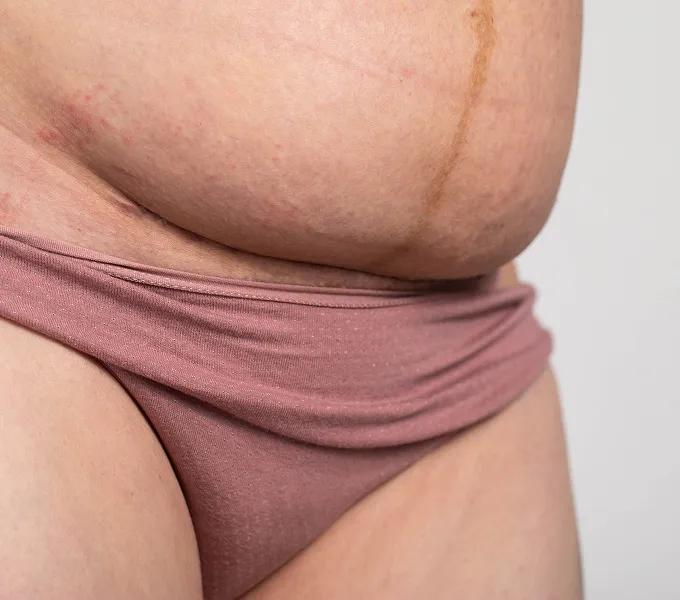
Yes, You Can Have Sex After Uterine Prolapse
You've recently given birth, and now you’ve been diagnosed with uterine prolapse. Suddenly, your mind is racing with questions and worries about how your body has changed. One thing you're likely to be wondering: "Can I still have sex?"
The short answer is yes — provided you want to have sex. Sex won’t injure your uterus (or any other organ that may be prolapsed). But the long answer is worth the read, because there’s so much to understand about sex and prolapse.
See below for for the facts on sex with uterine prolapse, plus tips for how to make sex post-pregnancy feel good — maybe even a bit better — than it did before.
What is sex like with uterine prolapse?
A uterine prolapse will almost certainly impact the way you feel about sex. It can impact sex physically, psychologically, and even relationally.
Many with POP feel less sexually attractive because of physical changes to their genitals. This can affect self-esteem, the ability to feel interest in sex and arousal.
If your uterus sits lower after prolapse, it can make intercourse uncomfortable or even painful. Pain can also result from tension due to worry over sex, injury during birth, or overusing your pelvic floor muscles as you try to recover from prolapse. You may even experience bladder leaks during sex.
These changes can impact your partner too. Some partners may notice that sex feels different. Others are so worried about your experience during sex that they are less interested is sex. And they also commonly will feel frustrated for you, over what seems like limited treatment options.
As overwhelming as it can feel, the most important thing to know is that with the right tools — like education about your body changes, effective treatment options, and some adjustments here and there to your usual routine — it won’t have to stay changed.
7 Tips to boost comfort during sex with a prolapse
- Communicate openly: Discuss your concerns and needs with your partner beforehand.
- Try sex again — only when you’re ready: make sure you're physically and emotionally ready for sex, especially after experiencing uterine prolapse or childbirth.
- Take it slow: Take it slow and listen to your body. Proceed at a pace that feels comfortable for you.
- Explore non-penetrative sex: Remember, sex is way more than just penetration. You can even leave your vagina completely out of the mix. Check out our recommendations on outercourse, sensate focus, and clitoral vibrators for more inspo!
- Get to know your vulva again: Whether it’s the first time looking since your prolapse (or the first time ever if you never thought to do this before), we suggest a hand mirror and practicing self-affirmations and positive self-talk about your genitals (check out this blog for more information on how to get bigger vulva energy). Also, check out our Visual Art Gallery to help shift how you feel about your vulva. Remember, all bodies are all different and they will naturally change throughout our lives, especially during pregnancy and in the postpartum.
- Pelvic floor exercises: Strengthening your pelvic floor muscles can improve support and sensation during.
- Try a buffer: If you have vaginal pain during sex, tools like Ohnut and personal lubricant can be really helpful in easing symptoms.
Sex positions to try with uterine prolapse
Sometimes, adjusting your positions during penetrative sex can make a world of difference in the way sex feels when you have a uterine prolapse. Often, positions that have you on your back, or with your hips in the air, can bring more pleasure (and not pressure).
Sex position to try: Lying on back, pillows under butt

Lie on your back in missionary position. Place a pillow or two under your hips to elevate your pelvis and your partner can penetrate you while on top. By elevating your pelvis, gravity will help your uterus ease back into a more normal position, allowing for more comfortable vaginal penetration.
Sex position to try: Sideways, pillows under hips

Lie on your back and place one or two pillows under your hips. Drape your legs over your partner’s hips for penetration. Have your partner lie comfortably on their side, facing you. Again, gravity is helping your uterus to rest higher in your pelvis which can make penetration more comfortable.
This position is also really helpful if deeper penetration (like you may experience in the above position) is painful or uncomfortable. The back of your thighs and buttocks will keep your partner from being able to penetrate too deep.
Sex position to try: Kneeling, pillows under knees

Start by kneeling on the bed or a comfortable surface, then lower your upper body so that your upper body is resting on a pillow. Your hips will stay up and your partner can then enter from behind. This position is advantageous for several reasons. Again, gravity to helps keep the uterus in a better position for penetration.
While specific positions can be helpful, it's important to remember that what works best can be different from person to person. Regardless of these recommendations, always err on the side of listening to your body and communicating with your partner.
Understanding uterine prolapse
Uterine prolapse is when your uterus drops down from its normal position, causing your cervix, which is the lower portion of the uterus, to slip down and take up space in your vagina. Depending on the severity of your prolapse, this can drop all of the way to, or below your vaginal opening.
Uterine prolapse is one type of pelvic organ prolapses (POP). It can lead to a variety of frustrating and bothersome symptoms like:
- Bladder leaks
- An inability to fully empty your bladder
- Pelvic heaviness or fullness
- Lower back or lower abdominal pain/ache
- Changes in vaginal discharge, or unusual vaginal bleeding
- Constipation or bowel leakage
- Pelvic or vaginal pain
- Tissue bulging from your vagina, or a feeling or falling out
How does the pelvic floor factor in?
The pelvic floor muscles, along with ligaments and connective tissues, support your pelvic organs. Uterine prolapse happens when the pelvic floor muscles and/or supportive ligaments of the uterus are injured or weakened.
Pelvic organ prolapse is more common than you might think, affecting up to as many as 1 in 2 people with a uterus at some point in their life.
Certain factors can make you more likely to have pelvic organ prolapse, for example:
- Vaginal childbirth
- One or more pregnancies
- Menopause
- Genetics
- Chronic straining
Pelvic organ prolapse is more common than you might think, affecting up to as many as 1 in 2 people with a uterus at some point in their life.
Treatment options for uterine prolapse
There are several treatment options available if you have uterine prolapse, including:
- Pelvic floor physical therapy: Work with a pelvic physical therapist to help you strengthen your pelvic floor muscles and improve pelvic organ support.
- Pessary: The unsung hero of the pelvic organ prolapse is the pessary, which is a removable device inserted into your vagina that can provide support, and so much relief from prolapse symptoms — you’ll want to take this out before sex though.
- Lifestyle modifications: There are so many small but doable strategies that can help relieve symptoms of uterine prolapse. For example, changes in diet, exercise, and daily activities can reduce strain on your pelvic floor, and ease symptoms.
- Vaginal estrogens: Topical hormone treatment is one medication-based tool that can help improve tissue health and support when low estrogen is contributing to your symptoms (like in the postpartum or menopause).
- Surgery: There are various surgical procedures to help repair prolapsed tissues including reconstructive and obliterative surgery. There are of course pros and cons to every surgery, but speaking with your healthcare team can help you understand which surgery would be best for you.
The choice for your best treatment depends on factors like how severe your prolapse is, your overall health, and your personal goals. It's best to check in with your healthcare team to determine the most appropriate approach for your specific situation. And don’t forget to reach out to the PTs at Origin Physical Therapy. They will not only make sure that you understand all of your treatment options, but they will help rebuild strength and support in your pelvic floor muscles and your sexual confidence — there’s no such thing as TMI.
Having a uterine prolapse doesn't mean your sex life is over. With the right approach, open communication — and perhaps a bit of experimentation — you can continue to have a fulfilling and satisfying sex life.




